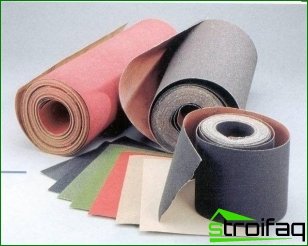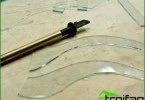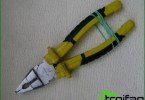Sandpaper refers to abrasive materials designed on paper, textile or other type of substrate, on which the abrasive layer is applied. Apply sandpaper for special tools or manual processing of the bases of various materials, allowing you to carry out preparatory work before painting, priming, grinding or to remove an obsolete paint layer. You can buy sandpaper in rolls, but if desired, you can use modern analogues, such as emery sponges. Let’s look at some guidelines for sandpaper selection.
The graininess of the material
Granularity is considered a very important indicator of abrasive material. This characteristic allows you to find out the content of particles that are per square inch of the surface. Coarse sandpaper has a small numerical characteristic of grain size. This indicator can range from 10 to 4000.
When using sandpaper with a grain size of 10 to 16, you will get a very rough surface treatment. This material allows you to remove varnish or varnish from the floor. When characterizing up to 40, you must understand that this is a rough abrasive material that allows you to effectively remove paint from wooden products.
To perform rough grinding, when the surface is cleaned of paint, an emery cloth with a grain size of up to 80 is used. But a material with a characteristic of 80-150 is considered quite gentle. It allows you to quite accurately level wooden surfaces, as well as perform smoothing by rough grinding. Such abrasive material allows intermediate grinding, to get rid of a variety of defects, including all kinds of drawings and marks. Such sandpaper is considered to be medium grit material..
If we talk about sandpaper with fine grain, then its indicator is in the range of 150-180. It allows final grinding of wooden structures, after which they can be treated with a primer mixture and painted. Sandpaper with characteristics 200-240 is considered very thin. It allows a high level of intermediate grinding. Such abrasive material is used after priming before painting the surface..
Super thin sandpaper has a grain size of 240-320. It allows you to finish polishing before painting wood coatings. With it, you can get rid of traces of dust, which in some cases appear after staining products.
With abrasive material that has a grain size of up to 4000, various work is carried out on grinding already painted wood. Such sandpaper will help to remove unnecessary gloss, which is typical for glossy substrates, as well as get rid of the smallest spots and surface damage..
Varieties of sandpaper
Sandpaper refers to abrasive materials designed on paper, textile or other type of substrate, on which the abrasive layer is applied. Apply sandpaper for special tools or manual processing of the bases of various materials, allowing you to carry out preparatory work before painting, priming, grinding or to remove an obsolete paint layer. You can buy sandpaper in rolls, but if desired, you can use modern analogues, such as emery sponges. Let’s look at some guidelines for sandpaper selection.The graininess of the material
Granularity is considered a very important indicator of abrasive material. This characteristic allows you to find out the content of particles that are per square inch of the surface. Coarse sandpaper has a small numerical characteristic of grain size. This indicator can range from 10 to 4000.
When using sandpaper with a grain size of 10 to 16, you will get a very rough surface treatment. This material allows you to remove varnish or varnish from the floor. When characterizing up to 40, you must understand that this is a rough abrasive material that allows you to effectively remove paint from wooden products.
To perform rough grinding, when the surface is cleaned of paint, an emery cloth with a grain size of up to 80 is used. But a material with a characteristic of 80-150 is considered quite gentle. It allows you to quite accurately level wooden surfaces, as well as perform smoothing by rough grinding. Such abrasive material allows intermediate grinding, to get rid of a variety of defects, including all kinds of drawings and marks. Such sandpaper is considered to be medium grit material..
If we talk about sandpaper with fine grain, then its indicator is in the range of 150-180. It allows final grinding of wooden structures, after which they can be treated with a primer mixture and painted. Sandpaper with characteristics 200-240 is considered very thin. It allows a high level of intermediate grinding. Such abrasive material is used after priming before painting the surface..
Super thin sandpaper has a grain size of 240-320. It allows you to finish polishing before painting wood coatings. With it, you can get rid of traces of dust, which in some cases appear after staining products.
With abrasive material that has a grain size of up to 4000, various work is carried out on grinding already painted wood. Such sandpaper will help to remove unnecessary gloss, which is typical for glossy substrates, as well as get rid of the smallest spots and surface damage..
Varieties of sandpaper
Often the abrasive material is divided into types depending on the types of substrate. Now we will talk about the characteristics of sandpaper with a paper base. Such an abrasive material has a significant density and excellently tolerates significant mechanical loads. If necessary, you can use sandpaper, which has a waterproof base, but it can be normal.
Among the strengths of this type of abrasive material is its affordable price. Due to the base made of paper, it is possible to maintain the shape, on such a basis you can apply the most crushed fractions of the abrasive. However, paper-based sandpaper has some drawbacks, the main ones being low wear resistance and strength..
Polyester and cotton can serve as a fabric basis in the manufacture of various types of sandpaper. Before applying the abrasive to the fabric, a special impregnation is performed, due to which the material acquires high resistance to moisture and increased strength. As a result, the product is considered very durable and flexible..
In sandpaper with a combined base, the method of gluing paper with textiles is used. If desired, in construction supermarkets you can buy a product that has a fiber base. However, such abrasive material is used exclusively in the factory on special emery machines. With its help, high-quality surface treatment is performed, which is characterized by a very high hardness index..
Abrasive Application Methods
The filling in sandpaper is open and half-open, but some materials use a solid or closed type filling. Products, in the manufacture of which the first two methods of filling were used, as a result, abrasive grains cover approximately half of the entire base. Such an abrasive material allows the processing of materials characterized by low surface hardness. This includes various tree species. The special structure of the base avoids the formation of all kinds of lumps; as a result, grinding wastes are simply removed and do not clog the space between the grains.
In sandpaper, the filling in which is of a closed or solid type, the surface is completely covered with abrasive grains. It is an ideal material for hard surfaces..
Having reviewed some of the recommendations for sandpaper selection, we will be able to choose the optimal type of abrasive material for certain surfaces.







